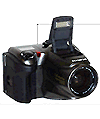I Use an Olympus D-600L Digital Camera
|
The camera I use to take the 3D pictures, the pictures through
the microscope, and many of the Science Toy pictures, is the
Olympus D-600L.
|
|
I have arranged with the Cyberian Outpost company to make the camera available to my readers at a very attractive price (it's still not cheap, but much less than I bought mine for!). If you are interested, simply click here or on the camera photo at the top of this page.
|
|
The main feature of the camera is its 1280 by 1024 pixel resolution. Not only does this make it possible to print 8x10 photos that look like they came from a 35mm film camera, but (perhaps more importantly) it enables me to crop the photos and enlarge parts of the picture and still be able to display high resolution pictures that are more than mere thumbnails.
|
|
The other requirement I had was the ability to screw on filters and third-party closeup lenses. Most digital cameras resemble little point-and-shoot film cameras with small fixed lenses. The D-600L accepts an inexpensive adapter ring that fits my 55 mm filters and lenses from my film camera.
|
|
Third, the Through-The-Lens (TTL) viewfinder is essential to good photography through a microscope or telescope, and is quite useful in composing good 3D pictures.
|
|
The camera can be controlled from the computer, so when taking pictures through the microscope or telescope, I can take the shot by clicking on a button on the computer screen. This makes it very stable, as there is no camera movement due to my fingers pressing buttons on the camera.
|
|
The autofocus, and autoexposure controls can be overridden, so the camera will take pictures in low light (such as through a microscope at high power) with the focusing done by the user's eye and the microscope fine focus controls using the Through-The-Lens viewfinder.
|
|
The camera is very light weight, and with 8 megabyte flash memory cards, I can take lots of pictures. Each 8 MB card holds 9 huge pictures, or over 50 640x480 shots for web site size images. The cards are the size of a large postage stamp, and slip into the camera quickly, so I can change 'film' much faster than with a film camera, which is great for wildlife shots.
|
